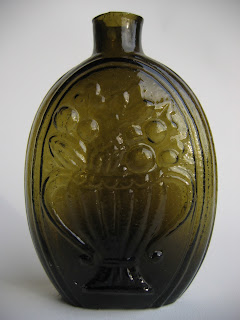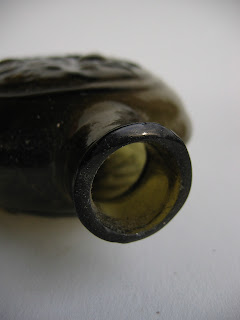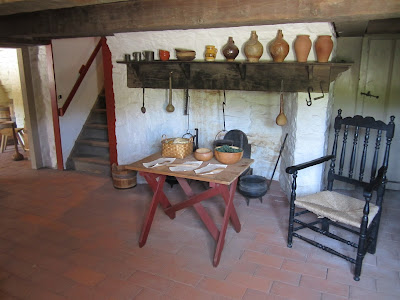






When I …purchased "a historical flask" (described in the Old Antiques Store post) using the money from my fruit jar sale and the twenty dollar gift from my grandmother, in the fall of my seventh grade year, I realized the end of a two year trail and held that end in my hand. The trail began in fifth grade when I went, one Saturday morning, to the public library and encountered a newly placed glass display case set up in the lobby housing several antiques on display including a half pint cornucopia and urn American (New England) pictorial flask. I was entranced by the display and the case but was smitten with the flask. There was a vague label ("Historical Flask Bottle") with a local man's name as the lender. That's not what smittened me. It was the …thing. It wasn't, to my eye, a "bottle". It was lying flat on its side; turtle shaped, turtle size and turtle colored but made of glass and had a raised decoration on the visible side of a cornucopia. I stared at it and then viewed it from adjusted angles about the case. I did this for weeks. And weeks. I understood the object was "glass" and "old". I was entranced by it. Defining my entrancement in hide sight, it was the "glass", the color of this glass, the raise decoration that had been clearly and cleverly molded onto this once soft glass and that this same glass was now hard and brittle but one could still "feel" the molten elasticity in the molded decoration. Further, the form DID look like the box and painted turtles I found all the time only this was "OLD" "GLASS". I was smitten,
As a fifth grader, "FINDING OUT" about this "THING" was a long research road that ended up with the unsatisfactory position of… "FINDING OUT" the "what this is"… in a big thick book that …only had a tiny little drawing way in the back of it… among similar "flasks" and crummy black and white pictures of other "old flasks"… but not one like this one and … never getting nearer to the actual "IT" than rubbing my nose on the glass case… which disappeared after six months… and… enhancing this research by not mentioning to anyone my smitten entrancement. I don't even know how I found out about "the book" which was (and still is) the basic classic reference to American Historical and Pictorial Flasks: George P. and Helen McKearin, AMERICAN GLASS, Crown, NY, 1941. (One may easily find a copy of this classic reference.)
There was a brief blank period of… no flask in the library - research over. THEN …at the old antique shop (see post of that title)… an IDENTICAL FLASK appeared for sale for $65.00. AND I could handle it… all over… without ANY restrictions and even freely talk about it and KEEP ON handling it over and over and KEEP ON talking about it EACH and every time I went there. My learning curve LEAPED forward for the handling and the talking yielded a great deal of true facts about the "thing" and …deep, deep, deepest deep "feel" for the object. I was not only smittened and entranced but INFORMED… very quickly. Then, one day, the fruit jar saga took place and …wham - bang… the flask was in my bedroom.
This old bottle, correctly called a cornucopia and urn half pint American pictorial flask in olive green bottle glass, numbered GIII-7 mold pattern by McKearin and made in New England at either a Connecticut or New Hampshire glassworks between 1820 and 1835… still smittens and entrances me to this day.
For others… it does not.
Most of the others are "bottle" or "flask" collectors who consider this flask mold pattern and therefore all of the flasks made in this mold to be… very, very, very, very, VERY common. So common do they commonly consider it's 'so common' to be common that the flask, today as I write is a …nothing. Traveling up the cash value scale in the past forty years to a high of about $150., the flask has fallen back to a "findable at" price of my original $65.00 and even… fifty bucks. Most often one finds them "kicking around" in an antiques shop for "$125.00" and …not going anywhere fast. And that's it.
THAT LAST means that outside of the collector community …that is fully jaded… the little flask has no following. None. Except in old New England homes filled with old New England things that have "always been there" and "show good taste". Either one "knows" what it is or… does not. The latter means, in most cases, not even noticing it. To my eye it is STILL "HOW CAN ANYONE not NOTICE IT?". Even as I write this …with a specimen next to me… I ponder "HOW" can anyone NOT be… smittened and entranced.
The brittle molded glass; light, and so elastically formed yet now HARD. The deep dirty but …crispy clear… green color… caused by heating molten glass with firewood in the New England woods. The mold blown decorative process… used in the New England woods second to it's …only… first usage… by the Romans. The lost-forever- NONCHALANCE- make of the single flask, one of thousands of surviving examples… by a glass blower MAN… who puffed one small controlled breath down his blowpipe to form a bubble of molten glass… and his BOY who closed that bubble in an iron mold. Then the MAN raised the raw molded flask from the mold. The BOY attached an iron "pontil rod" to it's bottom (with molten glass) and the MAN snipped the molded glass free from the blowpipe. The BOY "fire polished" this jagged …top lip of the flask by… sticking the flask (top lip first) back into the furnace "for a second" and then "finished" by… breaking the pontil rod off with a pop. The BOY turned to find the MAN ready with another bubble of glass ready for the mold. They did this all day, every day. The finished flasks were peddled and sold by the dozen as "general purpose containers" to …anyone who would buy any. They were then filled with anything and just about everything and … sold, used and… NOT thrown out due to their very, very obvious positive art qualities that are best summarized as "I LIKE IT". The abundant and therefore "common" qualities of this cornucopia and urn half pint flask are due to the abundant number made and the …"I like it" preservation of the flask… ever after… in old New England homes.
Discover all of this oneself, hunt one of these… glass turtles… down, buy it, handle it and keep it around. The positive art qualities, the old glass qualities, the legacy qualities and the simple "I like it" will last you the rest of your life and return all of your cash outlay in cultural and art discovery. If one is interested in early New England decorative arts, this old glass object is an open door into learning about them. As a single decorative glass object… in the New England home… one sends a knowing message when one displays this …very proper, very subtle and very classic New England pictorial flask.

































